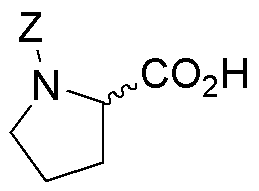Z-DL-proline is widely utilized in research focused on
- Peptide Synthesis: This compound serves as a key building block in the synthesis of peptides and proteins, particularly in the development of pharmaceuticals that require specific amino acid sequences.
- Drug Development: It plays a significant role in the design of new drugs, especially in creating compounds that mimic natural peptides, enhancing their efficacy and stability.
- Biotechnology: In the field of biotechnology, Z-DL-proline is used to enhance the solubility and bioavailability of therapeutic proteins, making them more effective in medical applications.
- Food Industry: This compound is also explored in food science for its potential as a flavor enhancer or preservative, contributing to improved taste and shelf life of products.
- Cosmetic Formulations: Z-DL-proline is incorporated into cosmetic products for its moisturizing properties, helping to improve skin hydration and overall appearance.
General Information
Properties
Safety and Regulations
Applications
Z-DL-proline is widely utilized in research focused on
- Peptide Synthesis: This compound serves as a key building block in the synthesis of peptides and proteins, particularly in the development of pharmaceuticals that require specific amino acid sequences.
- Drug Development: It plays a significant role in the design of new drugs, especially in creating compounds that mimic natural peptides, enhancing their efficacy and stability.
- Biotechnology: In the field of biotechnology, Z-DL-proline is used to enhance the solubility and bioavailability of therapeutic proteins, making them more effective in medical applications.
- Food Industry: This compound is also explored in food science for its potential as a flavor enhancer or preservative, contributing to improved taste and shelf life of products.
- Cosmetic Formulations: Z-DL-proline is incorporated into cosmetic products for its moisturizing properties, helping to improve skin hydration and overall appearance.
Documents
Safety Data Sheets (SDS)
The SDS provides comprehensive safety information on handling, storage, and disposal of the product.
Product Specification (PS)
The PS provides a comprehensive breakdown of the product’s properties, including chemical composition, physical state, purity, and storage requirements. It also details acceptable quality ranges and the product's intended applications.
Certificates of Analysis (COA)
Search for Certificates of Analysis (COA) by entering the products Lot Number. Lot and Batch Numbers can be found on a product’s label following the words ‘Lot’ or ‘Batch’.
*Catalog Number
*Lot Number
Certificates Of Origin (COO)
This COO confirms the country where the product was manufactured, and also details the materials and components used in it and whether it is derived from natural, synthetic, or other specific sources. This certificate may be required for customs, trade, and regulatory compliance.
*Catalog Number
*Lot Number
Safety Data Sheets (SDS)
The SDS provides comprehensive safety information on handling, storage, and disposal of the product.
DownloadProduct Specification (PS)
The PS provides a comprehensive breakdown of the product’s properties, including chemical composition, physical state, purity, and storage requirements. It also details acceptable quality ranges and the product's intended applications.
DownloadCertificates of Analysis (COA)
Search for Certificates of Analysis (COA) by entering the products Lot Number. Lot and Batch Numbers can be found on a product’s label following the words ‘Lot’ or ‘Batch’.
*Catalog Number
*Lot Number
Certificates Of Origin (COO)
This COO confirms the country where the product was manufactured, and also details the materials and components used in it and whether it is derived from natural, synthetic, or other specific sources. This certificate may be required for customs, trade, and regulatory compliance.


